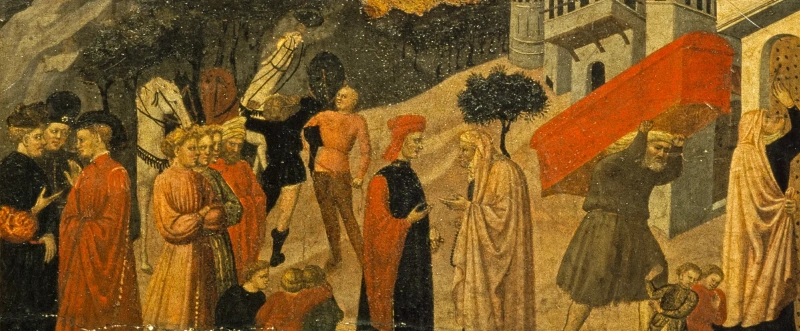Jean the Younger Clouet and his son françois are the greatest masters of the French school portrait of a courtier of the 16th century Perhaps, the family of Clouet comes from the Netherlands, where the name was common in the late 15th century Jean Clouet the Younger - the son of the painter Jean Clouet the Elder (mind. approx. 1500), sometimes identified with Melenskim master. He arrived in France during the reign of Louis XII, in 1516 became one of the court painters of Francis I, and later was appointed chief painter to the king.
French artist, probably of Dutch origin, Jean Clouet, like his brother Paul, an artist at the court of the Duke of Navarre, was a native of the Netherlands. Perhaps he was in the service of Louis XII, but was first mentioned in 1516 as a painter of Francis I (with a salary of 180 livres, equal to the salary of Perrela, Bourdichon, Nicola Belen and Bartholomew Gety). In 1521-1525 he lived in the Type, where he married a daughter of a jeweller, and may 10, 1522, he signed a contract for execution of the image of St. Jerome for TS. Saint-Pierre-du-Boil in the Type by order of the uncle of his wife. In 1523, Clouet creates a Golden model of the "Four Evangelists" for the embroiderer from Paris, where he settled, probably in 1525-1527. In 1529 he replaces Bourdichon and becomes equal to Perreau, and in 1533 - a Valet of the king: his name is repeatedly mentioned in the accounts (1529, 1537), according to a document dated November 1541, by this time he was already dead. Jean Clouet was rich and famous: in 1539 Clement Marot called him the equal of Michelangelo. In his Studio he worked, in particular, Petit Jean champion (who helped him in 1525, and later became the king's Valet) and his son Francois Clouet.
We do not know any of the subscription work of Jean Clouet. Perhaps, he did pencil drawings (about 130, approx. 1536-1540, mainly Chantilly, musée condé) with a picture of a court that relate to the documented period of his work and are preparatory drawings for the paintings. Among them a portrait of Guillaume Bude (sketch to a beautiful portrait in the Metropolitan Museum in new York). By analogy with these figures L. Dimie attributed to Clouet, six portraits, of the Dauphin Francis (Antwerp, Cor. Museum of fine arts), Charlotte French (before meeting him), Francis 1 (Paris, Louvre), Claude of Lorraine, Duke of guise (Florence, Palazzo Pitti), Louis of Cleves, count de Nevers (Bergamo, Accademia Carrara), "a Man with a book of Petrarch" (London, HAMPTON Court Palace). These attributions are accepted, and Charles sterling, who, like E. blant, denies the authorship of Clouet portrait of Francis I (played, in his opinion, Francois Clouet) and amends the list of the portrait of Marie d Assigny (Edinburgh, NAT. Gal. Scotland) and a portrait of "Men of gold" (St. Louis, mo, Mountains. Museum). Clouet, it is possible to attribute also a portrait of Madeleine French (not preserved before - Paris, collection E. Rothschild) and a portrait of Charlotte French (Minneapolis, Institute of arts). In the album of prints Teve "Hommes illustres" played and lost portrait Oronce fin. Also need to mention and portrait miniatures, sketches, some of which are also in the musée condé ("Portrait of Charles de Cossey, the count de Brissac", new York, the Metropolitan Museum of art), and portraits in the round medallions of the heroes of the battle of Marignane ("Commentaries on the Gallic war", Paris, NAT. library), which can be attributed to Perreau. The authorship of "the Equestrian portrait of Francis I" (Paris, Louvre) seems to be controversial; it could perform as Jean and Francois Clouet.
Pictorial works of Jean Clouet, is so incomplete today, was once very significant. It consists exclusively of portraits - a genre to which the artist turned on his arrival in Paris and which brought him huge success. This waist - length portraits, generally of a small size, the model's face is lit with even light, enough hands awkwardly placed in the foreground. Never straying from its Dutch origins, especially noticeable in the early works of the artist, the art of Jean Clouet, was influenced by the French (Fouquet, the master of Moulins, Perreal) and Italian (Solario, Leonardo da Vinci) were developed in the direction of monumentality, truthfulness and simplicity. His rigorous drawings in sanguine and charcoal devoid of unnecessary accessories; the master is absorbed here by the study of the expression of the face model. Although these drawings were, as a rule, the sketches for picturesque portraits, they have exceptional intrinsic value. Jean Clouet was the Creator of "pencil" genre that developed in France in the first half of XVII century.
-
Las obras han gustado2 users
- Artworks in 4 selections
Publicaciones
Exposiciones
Todas las exposiciones del pintorBandeja
Gótico / Renacimiento 1300-1550exhibition finished

Gótico / Renacimiento 1300-1550started












